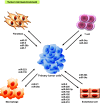Cell-to-cell communication: microRNAs as hormones
- PMID: 29024380
- PMCID: PMC5709614
- DOI: 10.1002/1878-0261.12144
Cell-to-cell communication: microRNAs as hormones
Abstract
Mammalian cells can release different types of extracellular vesicles (EVs), including exosomes, microvesicles, and apoptotic bodies. Accumulating evidence suggests that EVs play a role in cell-to-cell communication within the tumor microenvironment. EVs' components, such as proteins, noncoding RNAs [microRNAs (miRNAs), and long noncoding RNAs (lncRNAs)], messenger RNAs (mRNAs), DNA, and lipids, can mediate paracrine signaling in the tumor microenvironment. Recently, miRNAs encapsulated in secreted EVs have been identified in the extracellular space. Mature miRNAs that participate in intercellular communication are released from most cells, often within EVs, and disseminate through the extracellular fluid to reach remote target cells, including tumor cells, whose phenotypes they can influence by regulating mRNA and protein expression either as tumor suppressors or as oncogenes, depending on their targets. In this review, we discuss the roles of miRNAs in intercellular communication, the biological function of extracellular miRNAs, and their potential applications for diagnosis and therapeutics. We will give examples of miRNAs that behave as hormones.
Keywords: cell-cell communication; circulating miRNAs; exosomes; extracellular vesicles; microRNAs; tumor microenvironment.
© 2017 The Authors. Published by FEBS Press and John Wiley & Sons Ltd.
Figures


References
-
- Al‐Khalaf HH and Aboussekhra A (2017) p16INK4A induces senescence and inhibits EMT through microRNA‐141/microRNA‐146b‐5p‐dependent repression of AUF1. Mol Carcinog 56, 985–999. - PubMed
-
- Ambros V (2004) The functions of animal microRNAs. Nature 431, 350–355. - PubMed
-
- Arita S, Baba E, Shibata Y, Niiro H, Shimoda S, Isobe T, Kusaba H, Nakano S and Harada M (2008) B cell activation regulates exosomal HLA production. Eur J Immunol 38, 1423–1434. - PubMed
Publication types
MeSH terms
Substances
Grants and funding
LinkOut - more resources
Full Text Sources
Other Literature Sources

